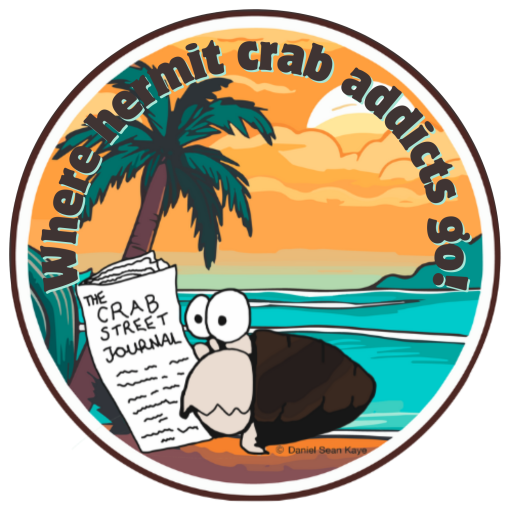Summary by Stacy Griffith
Despite the name, hermit crabs are not solitary creatures. They live in large communal colonies of other hermit crabs and they are host to other species that attach to shell of the hermit crab, bore into the shell or live within the central cavity (lumen) of the shell. Discussed here are symbionts that live on, within or bore into shells worn by hermit crabs.
Land hermit crabs can harbor nine species of mites that attach to the gills.
Addition of note are polychaete worms that bore into the shells of hermit crabs. 35% of hermit crab shells in the Phillipines may contain an adult female worm. While this study focuses on marine hermit crabs, there is a possibility of a land hermit crab inhabiting one of these shells. The study does not discuss the life span of the worm once out of the water. These worms prey on hermit crab eggs within the shell.
Other stats relating to parasites of marine hermit crabs:
There are 100 species of polychaetes, 26 are endolithic (boring) which include:
Polydorids, polydora robi and polydora umanigvora which prey on host hermit crab eggs with negative impact on breeding.
An adult female worm (P. robi) feeds on eggs of the host hermit crab, eating a maximum of 70 eggs over 6 hours.
10 other invertabrates are known egg predators, including: Cnidarians (anemones and hydroids), Flat worms (stylochus zebra), Polychaetes (dipolydora common salis and lepidonotus sublevis).
185 species of parasitic isopods (family Bopyrideie) infest hermit crabs worldwide.The subfamily Athelginae attach to abdomen. The subfamily Psuedioninae attach to branchial cavity. Female isopods pierce the cuticle of the hermit crab and feed on haemolymph. This can cause parasitic castration in the hermit crab.
Land crabs are colonized by nematodes (Carson 1967), mites, Drosophila larvae, and copepods, and their exoskeletons are degraded by certain bacteria (Iversen & Beardsly 1976). [1]
Hermit Crab Parasitic Mites
- Askinasia antillarum sp. n., which was found on the hermit crab Coenobita clypeata in multiple locations. This species was previously identified as Askinasia sp. n. “C” by YUNKER in 1970.
- Ewingia cenobitae, originally described by PEARSE in 1929, was found on a crab identified as Coenobita diogenes, which is actually C. clypeata.
- Hoogstraalacarus tiwiensis and Askinasia aethiopicus were found on Coenobita rugosa in Kenya.
- Askinasia sinusarabicus was found on Coenobita jousseaumi in Egypt.
The family Ewingiidae is completely specialized for pagurids (hermit crabs) and freshwater crabs. Mites in this family attach to the gills or leg hairs of their hosts.
Potential Risks
I have not found a great deal of research on parasitic mites or the risks they introduce to hermit crabs but some assumptions can be made from this paper.
Based on the attachment sites, it can be inferred that these mites could potentially negatively impact the crabs by:
- Interfering with respiration when attached to the gills.
- Impairing movement or mating when attached to the leg hairs.
- Causing irritation and discomfort due to their strong attachment using clasping organs.
References
- Grooming structure and function in some terrestrial Crustacea by Jeff G. Holmquist
- The not so lonely life of Hermit Crabs: Studies on Hermit Crab Symbionts by Jason D. Williams
- Notes on the Ewingiidae (ACARI, AST1GMATA) living in association with paguids and fresh-water crabs (Crustacea), with description of a new genus and a new species by A. FAIN (1), C. E. YUNKER (2), J. VAN GOETHEM (3) and D. E. JOHNSTON (4)


